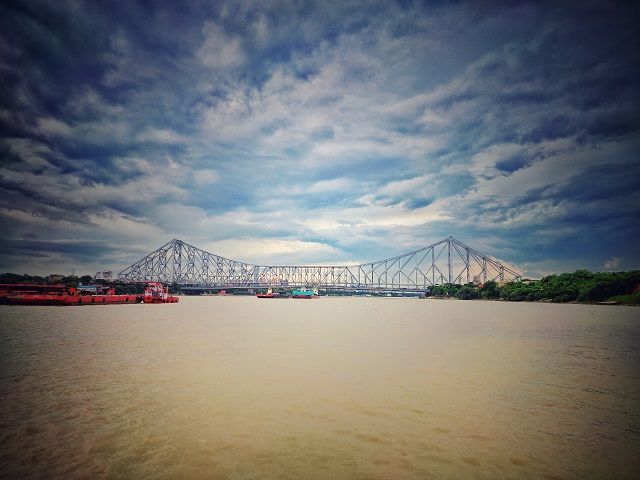Howrah, West Bengal's second-largest city and the twin city of Kolkata, is a popular tourist destination. This city has a history that goes back over 500 years. Plan a journey to this location for your upcoming holiday; it is also an industrial city. Howrah offers a variety of tourist attractions that can be explored. The Howrah Bridge, a cantilever bridge, is one of the most major tourist destinations out of all the attractions. It is a one-of-a-kind bridge that ranks sixth in terms of size worldwide. It is 2150 feet long and has a span that hangs directly over the Hooghly River.
Since it had replaced the pontoon bridge when it was first opened in 1943, the bridge was initially known as the New Howrah Bridge. It connects Kolkata and Howrah, two cities. It was given the name Rabindra Setu in 1965, and this name was retained to pay homage to the esteemed Bengali poet Rabindranath Tagore. However, it is now more commonly referred to as the Howrah Bridge. This is one thing that you must absolutely not skip seeing when in West Bengal. The bridge's majestic presence is nothing short of a wonderful wonder.
One of Kolkata's most notable landmarks is the Howrah Bridge. There are four bridges in total: the Nivedita Setu bridge, the Vivekananda Setu bridge, and the Vidysagar Setu bridge. According to reports, the bridge carries 100,000 vehicles and 150,000 pedestrians daily. This bridge was the third-longest cantilever bridge when it was first built, but it is currently ranked sixth. It connects to the renowned Howrah station and acts as a perfect entryway to Kolkata. A census taken in 1946 revealed that there were 12100 people and 27400 cars using the bridge each day. In fact, the bridge used to transport trams that departed from Howrah station terminus in the distant past. Tram operations on the bridge were stopped because it appeared that the bridge could not support the weight of the heavy loads. The bridge can only support 60,000 vehicles at this time, although it still carries close to 90,000 vehicles every day. Additionally, there is a separate footpath for people to use on the bridge.
FACTS ABOUT HOWRAH BRIDGE
One of Kolkata's most significant landmarks is the Howrah Bridge, which was renamed the Rabindra Setu in 1965 in honour of Nobel laureate Rabindranath Tagore. When a traveller is asked to immediately picture the City of Joy, this recognisable structure is likely to be the first thing that comes to mind.
The Howrah Bridge in Kolkata has long served as a reminder of the city's past, both before and after Independence, when it served as the nation's capital. Additionally, it has earned its rightful place in the representation of the city and its popular culture in books, movies, and other media.
Although Howrah Bridge is a well-known site for both tourists and locals, very little is known about its unusual history. We've put up a list of some interesting information for curious travellers.
When it was first constructed, the Howrah Bridge's official name was the New Howrah Bridge. This is because it was a straightforward pontoon bridge before it was put into service in 1943. But after the Howrah railway station opened in 1906, there was a requirement for a well-built bridge for improved to and fro travel. It's incredible, but true, that not a single nut or screw was used to unite the variety of metallic sections that made up the enormous construction of the Howrah Bridge. Instead, two or more plates were connected by inserting a piece of metal through the hole in the plates and pressing on the other side.
The Howrah Bridge, which has been there for more than seven decades, has seen some of the most significant historical events in the globe, including the Second World War. Even though the Howrah Bridge is currently primarily used by cars, scooters, buses, and other wheeled vehicles, it originally carried Kolkata's famous trams.
Actually, a single tram was the first kind of transportation to be employed on the bridge. Due to rising vehicular traffic on the bridge, trams were prohibited in 1993.
Howrah Bridge is today regarded as the pride of Kolkata and West Bengal in general. Given that it connects the city to the Howrah Railway junction, this bridge is frequently referred to as the "gateway of Kolkata." The Howrah Bridge's connectivity is as follows. At the opposite end of the bridge, the Mullick Ghat Flower Market is in a very colourful but chaotic state. One of the busiest cantilever bridges in the world today, it sees over 100,000 vehicles and more than 150,000 pedestrians per day. If you live close to the Howrah Bridge area, you must go there at least once. As the Howrah Bridge is illuminated at night, the scene is amazing and will have you in awe of its incredible beauty.
By-
Sriparna Mukherjee
Student
Amity University Kolkata


Comments
Post a Comment